A Zest for Advocacy
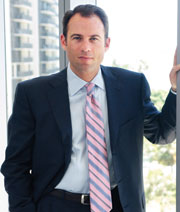
Michael J. Avenatti, JD ’00, established a law scholarship for future trial lawyers enrolled in the part-time evening division program.
There is nothing faint-hearted about Michael J. Avenatti, JD ’00. From aggressively pursuing justice for clients to driving a Porsche 997 professionally for fun, Mr. Avenatti moves full steam ahead.
Mr. Avenatti’s vitality also applies to his philanthropy to GW Law. His first gift came in 2000 when the ink on his degree was barely dry. The Michael J. Avenatti Award for Excellence in Pre-Trial and Trial Advocacy is given annually to a member of the graduating JD class for demonstrating excellence in pre-trial and trial advocacy courses. Mr. Avenatti followed this with a gift to renovate the Jacob Burns Moot Court Room, where he participated as a member of GW’s Moot Court Board from 1997 to 1999.
Mr. Avenatti’s latest donation is a $250,000 endowed scholarship—a five-year pledge for an annual $10,000 scholarship and a $40,000 investment in an endowment. After five years, the endowment’s investment income will fund annual scholarships. Recipients of the Michael J. Avenatti Scholarship will be JD students having “diverse undergraduate extracurricular achievements and demonstrated leadership qualities indicating unique potential for becoming an effective trial advocate, with particular emphasis on prior work experience. First preference shall be given to students enrolled in the part time evening division,” as defined by the award.
“I think students enrolled in evening classes face more challenges,” explains Mr. Avenatti, who was a GW Law evening division student. “They are effectively juggling two jobs—their regular day job and law school. The financial aid community sometimes overlooks them because they don’t fit the traditional law student profile. This scholarship provides them with another opportunity to receive financial aid.”
Mr. Avenatti found GW Law’s evening program to be “exceptional and challenging.” He particularly enjoyed torts taught by Professor Jonathan Turley and pre-trial advocacy taught by Professor Alfreda Robinson. “This is why I endowed an award to benefit and promote the Pre-trial Advocacy Program. I think it is an outstanding program,” Mr. Avenatti says.
Advocacy also spurred Mr. Avenatti to become an attorney. “The desire to be an advocate and speak for others drove me to the legal field. This drive went hand-in-hand with my experience in politics,” he says.
Mr. Avenatti’s path toward law began after graduating from the University of Pennsylvania in 1996. A job with a political consulting firm run by Rahm Emanuel (now President Barack Obama’s White House chief of staff) brought him to Washington, D.C., where he enrolled in GW Law School’s evening division. During his stint in politics, Mr. Avenatti worked on more than 100 campaigns nationwide.
Following his GW Law graduation, he joined O’Melveny & Myers as an attorney in his native state of California. The switch to the plaintiff’s side came within three years, when Mr. Avenatti joined Greene Broillet & Wheeler. In 2006, he settled a $22.5 million case against accounting giant KPMG, which harmed Mr. Avenatti’s client by not discovering a multi-year embezzlement by a chief financial officer. He also settled before trial a $10 million defamation case against Paris Hilton and an idea theft lawsuit against Mark Burnett, the producer of The Apprentice reality show.
During work on one case against KPMG for professional malpractice and negligence, Mr. Avenatti teamed with attorneys Michael Eagan and John O’Malley. This collaboration led to establishment in 2007 of Eagan O’Malley & Avenatti. The firm took the unusual move of promoting itself as a contingency firm, with an emphasis on representing businesses in multi-million dollar civil litigation cases.
One of the firm’s first victories was an audit malpractice case, which produced a $31.8 million verdict ($40 million with interest) for the plaintiff in late 2008. This past September, the firm announced a class action suit against publicly traded Service Corporation International alleging improper burials and discarding of human remains. Mr. Avenatti is lead attorney on this case and estimates the suit could award in excess of $500 million for the plaintiffs, who are families of the deceased.
With offices in Los Angeles, Orange County, and San Francisco, Eagan O’Malley & Avenatti employs about a dozen attorneys. Mr. Avenatti’s practice includes business litigation, trial practice, products liability, and personal injury.
On the personal side, Mr. Avenatti has two interests close to his heart. One is spending time with his daughters, Lauren, 7, and Nicole, 5. The other is auto racing, which he has done since 1992.
Mr. Avenatti considers racing part of his overall philosophy: “Life is meant to be lived; there are no dress rehearsals.”
Mr. Avenatti plans to race professionally next year on the American Le Mans circuit, driving a factory prepared Porsche 997. In 2007, he raced at Daytona International Speedway as part of the KONI series—while also donating his car’s livery for the race to promote Paul Newman’s Hole in the Wall camps for seriously ill children.
Meanwhile, Mr. Avenatti is expanding his support to GW as a new member of the Law School’s Board of Advisors. He attended his first meeting this past fall.
“Looking around the room was a rather humbling experience. The breadth of experience and knowledge was pretty staggering. I considered myself lucky to just be in the room,” Mr. Avenatti says. “As a board member, I’m hoping to do everything I can to provide the same opportunities for students at GW that I had, and to further grow GW Law School’s reputation as one of the premier law schools in the country.”
—Kathleen Kocks
Scholars and Benefactors Meet at Dinner
The fall Dean’s Dinner highlighted the significance of scholarship support and its life-changing effects on GW Law students and donors alike. Three students spoke to dinner guests about how financial aid made their law school experience possible, and other students were able to meet and thank their benefactors in person.
The 2009-10 Burns Merit Scholars and the 2009-10 Thomas Searing Jackson Scholar met with Dr. Rosalie Burns Goldberg and Dr. Herbert Goldberg at the dinner. The Jacob Burns Merit Scholarship was established in 1988 by Jacob Burns, LLB ’24, and the Jacob Burns Foundation to award substantial grants annually to first-year Juris Doctor candidates without regard to financial need in order to attract our nation’s most promising legal scholars. The Thomas Searing Jackson Scholarship honors Thomas Searing Jackson, JD ’35, and was established in 1989 by the law firm Jackson & Campbell.
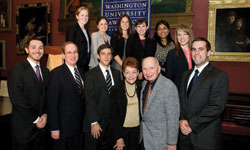
From left to right, front row: Noah Fortinsky (2L), Dean Frederick M. Lawrence, John Murphy (3L), Dr. Rosalie Burns Goldberg, Dr. Herbert Goldberg, Thomas Searing Jackson scholar David Bagby (2L). From left to right, back row: Emily Pierce (2L), Lauren Ingegneri (3L), Ariel Wade (3L), Jennifer Frey (2L), Ami Shah (1L), and Alissa Fideli (2L).
Dave Scavone
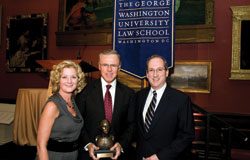
Dean Frederick M. Lawrence presented J. Richard Knop, JD ’69, and his wife, Leslee Belluchie, with a bust of George Washington to commemorate Mr. Knop’s contribution to the Class of ’69 40th Reunion Gift.
Dave Scavone
|
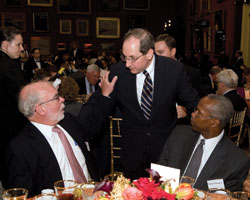
Dean Frederick M. Lawrence catches up with Richard Champion, JD ’71 (left), and William Bennett Jr. (right) at the Dean’s Dinner.
Dave Scavone
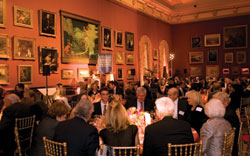
The Renwick Gallery’s Grand Salon provided an art-filled setting for the 2009 Dean’s Dinner. A record number of guests heard from Board of Advisors Chair Douglas Davidson, JD ’71, Dean Frederick M. Lawrence, and several scholarship recipients who shared their life-changing experiences thanks to financial aid.
Dave Scavone
|
Fall Board Meetings
The Fall Board meetings’ new format, beginning with a panel discussion on Friday afternoon and including a plenary session on Saturday morning, allowed ample time for participants to share their experiences.
The challenges and opportunities facing the legal profession and legal education were addressed from different perspectives, although there was general agreement that change is underway. During the plenary session, Professor Tom Morgan discussed examples of the new dynamics based on his book The Vanishing Lawyer: The Ongoing Transformation of the U.S. Legal Profession, inspiring a wide-ranging conversation.
During the meetings, scholarship funding was generally acknowledged as the Law School’s highest priority. Providing financial assistance aids GW Law in attracting top-flight candidates and in allowing its graduates to avoid onerous debt, leading to broader career choices.
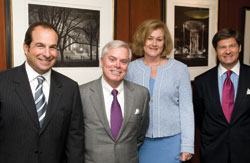
GW Trustee Robert Tanenbaum, JD ’82, and GW Law School Board of Advisors members William Shawn, JD ’73; Corinne Ball, JD ’78; and Bobby Burchfield, JD ’79, presented a panel discussion on the challenges posed by the changing legal profession at the board’s fall meeting.
Dave Scavone
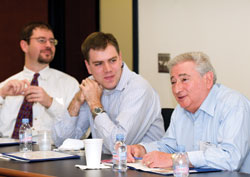
Members of the Intellectual Property Advisory Board engaged in focused discussions during the Alumni Weekend 2009 board meetings.
Dave Scavone
|
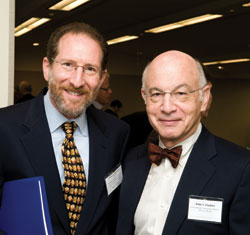
Associate Professor of Law and Co-Director of the Government Procurement Program Steven Schooner, LLM ’89, (left) and John S. Pachter, JD ’66, LLM ’70, at the Government Contracting Industry Advisory Board meeting.
Dave Scavone
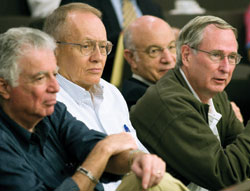
Advisory board members participate in plenary session discussion at the October meeting.
Dave Scavone
|
The Lee Legacy of Giving
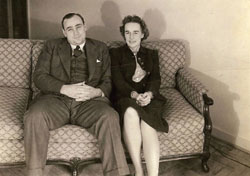
John William Lee, JD ’37, and his wife, Ruth Elizabeth Lowry Lee, helped dozens of nieces, nephews, and children of friends obtain higher education. The couple willed to GW Law nearly $197,000, which will be used for a scholarship. This photo was taken circa 1945.
If you must choose one word to describe John William Lee, JD ’37, and his wife, Ruth Elizabeth Lowry Lee, it would be giving. Even in the final acts of their lives, the couple was generous, willing hundreds of thousands of dollars to universities that gave them the means to help untold others over the years.
GW Law School is one beneficiary of their philanthropy and recently received a gift of nearly $197,000, which will establish an unrestricted scholarship—The John W. Lee Memorial Scholarship Fund. The gift will be used to create an endowment, producing an annual scholarship for GW Law students.
“In our family, higher education is of primary importance,” says Louise Hart, the niece of Mr. and Mrs. Lee and a nurse with a doctorate in nursing science. “Uncle John and Aunt Ruth were very generous in helping dozens of nieces, nephews, and children of friends obtain education. This gift is another way they continue to help others achieve success.”
Mr. Lee benefited from a family donation of sorts when he set off for college. His older brother (Ms. Hart’s father) ran the family farm to provide for the family while some of his five brothers and three sisters attended college. Mr. Lee also worked to support himself through his schooling and received some scholarships. There was also time for athletics, a family passion, with Mr. Lee and two of his brothers playing on the football team while earning undergraduate degrees at the University of Oklahoma.
After getting his pharmacy undergraduate degree in 1930, Mr. Lee attended the University of Michigan to earn a master’s in pharmaceutical chemistry. He then moved to Washington, D.C., where one of his brothers also lived and began teaching pharmaceutical chemistry at George Washington, eventually becoming an associate professor. After a while, he entered GW Law School to pursue his JD.
“He used to tell me he went to law school because he was bored. He was rooming with friends who were attending GW Law School’s evening division. This left Uncle John home at night with no friends and nothing to do. Before long, he was enrolled at GW Law School and on his way to a successful legal career,” Ms. Hart says.
After completing law school in 1937, Mr. Lee became a patent attorney with American Cyanamid in Connecticut. There he met Ruth Lowry, who had earned a bachelor’s in chemistry from Cornell University in 1938 and was working in one of the company’s labs. In 1941, they married and soon moved to the Indianapolis, Ind., area where Mr. Lee joined Pittman-Moore (later a division of Dow Chemical) as a patent attorney and then coordinator of research. In 1963, he became administrative director of research at Dow Human Health Research and Development Laboratories. In his last years with Dow, Mr. Lee postponed his request for early retirement to become a part-time consultant for the Dow lab’s development, acquisition, and use of patents.
While Mr. Lee worked, Mrs. Lee managed the household and contributed her time to numerous civic organizations. One was the Indianapolis Visiting Nurses Association, also a recipient of the couple’s posthumous generosity, which established the Ruth Lee Visiting Nurse Service Endowment Fund. Mrs. Lee also worked many hours for the Indianapolis Alzheimer’s Association on several committees and personally counseling family caregivers. She was an avid reader and a writer, publishing a book on Alzheimer’s care and regularly corresponding with an extended circle of family and friends.
Mr. and Mrs. Lee enjoyed farming, gardening, and sports, as well as raising and showing Brittany spaniels. The couple had no children, but they shared their resources with others.
“They were instrumental in the raising and mentoring of numerous nieces, nephews, and children of their friends,” Ms. Hart reports. “Most summers found at least one and sometimes many more children visiting for various lengths of time. Children were taught to ride horses and pick berries in exchange for good food and excellent long talks about life and how to contribute to the world around them. Many educational ‘scholarships’ from Uncle John and Aunt Ruth assisted those same children to reach their goals of higher education and accomplishments in life.
“The couple was known for their annual Fourth of July celebrations, which included great food, games, songs, rides, and mint juleps. They sponsored and held numerous Lowry and Lee family reunions every five years. Hotels were paid, food purchased, and events planned, including huge volleyball games and croquet tournaments that lasted for 15 years.”
Mr. Lee died Oct. 22, 1992, at age 86, and Mrs. Lee passed away April 15, 2007, two months shy of her 90th birthday. At their funeral services, many nieces and nephews spoke of their generosity whenever the family needed money or other support. They particularly recalled Mr. Lee’s talent of focusing on them and listening as they talked about their lives and interests.
In addition to endowing a scholarship at GW Law School, the Lees gave gifts to the University of Oklahoma, the University of Michigan, Cornell University, and Smith College, where Mrs. Lee’s aunt graduated.
“They continued the tradition of our family,” Ms. Hart concludes. “Helping others get educations so they can do the same when they are able.”
—K.K.
Giving Back With Generosity
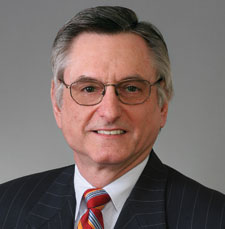
Philip C. Stahl, JD ’74, received a merit scholarship during his time at GW; now he’s returning the favor by creating his own endowed scholarship.
For Philip C. Stahl, JD ’74, philanthropy to GW Law School includes donations and funds for buildings as well as personal time. His latest gift, an endowed scholarship, is personally rewarding, as it continues a legacy he enjoyed as a GW Law student.
“At the end of my first year at GW, I received a full merit scholarship for the next two years,” Mr. Stahl explains. “So I was the recipient of an excellent legal education and the generosity of the person who endowed the scholarship. Because of it, I graduated from law school almost debt free.”
Mr. Stahl is returning the favor through the Philip C. Stahl Scholarship, a merit scholarship for students pursuing a JD degree. The gift consists of a scholarship for five years and an endowment contribution for five years that will sustain the annual scholarship into the future.
Mr. Stahl’s philanthropy to GW Law began in 1976. Notably, he was a lead donor for the new Law School building; the office of the senior associate dean for administrative affairs is named in his honor. More recently, he and classmate Carol Elder Bruce, JD ’74, led the effort to raise more than $265,500 from the Class of ’74 during a reunion in October.
Mr. Stahl’s continued support is driven by the role his GW Law education plays in his success. His decision to attend GW Law came a year after he graduated from the University of Maryland in 1970.
“I met a very interesting person in his 40s who, though well educated, expressed regret he didn’t pursue a law degree. I decided to look into law school, and GW was right there,” Mr. Stahl reminisces.
“I didn’t know what the legal profession was all about, and after my first day of class, I was scared and motivated to meet these new challenges. I studied long and hard, was selected for the Law Review and became an editor, had a summer associate job with Kirkland & Ellis in Chicago, and did a few ad hoc research assistant jobs for a retired professor.”
His GW Law education was embellished by extraordinary legal events in Washington, D.C. “The Supreme Court decided Rowe v. Wade; the Pentagon Papers case was decided. There was United States v. Nixon and the Watergate hearings. Our commencement speaker was Leon Jawarski, the Watergate special prosecutor. There was a lot going on,” Mr. Stahl says.
After graduation in 1974, Mr. Stahl worked briefly for Kirkland & Ellis in Chicago, Covington & Burling in Washington, and then returned to Chicago to work at Reuben & Proctor. The firm merged with Isham Lincoln & Beale, but it dissolved within two years.
This was beneficial for Mr. Stahl, who joined other colleagues to launch Grippo & Elden in May 1988. It was a good fit. Mr. Stahl served as the firm’s first managing partner and a member of the executive committee. In January, he withdrew from his executive and management positions to become a full-time practicing lawyer again.
Mr. Stahl’s expertise lies in litigation and arbitration in such areas as insurance coverage, professional liability, partnership and fiduciary disputes, employment disputes, and property ownership, development, and financing disputes.
“I have litigated many coverage disputes for insurance companies against the best lawyers in America representing policyholders. I am especially pleased about litigating one case in Florida bankruptcy court and up to the 11th Circuit Court of Appeals in Atlanta, Ga., then getting a favorable judgment for my client,” Mr. Stahl says. “I’ve also resolved many insurance coverage cases creatively through negotiation. These have involved such diverse matters as asbestos, silicon breasts, and even clergy abuses.”
A case that tested Mr. Stahl’s tenacity and expertise took on the state of Illinois. The state passed a statute preventing real estate brokers from sending solicitation materials to homeowners.
“My client was prosecuted, but our position was that real estate solicitation is protected because the First Amendment protects commercial speech,” Mr. Stahl says. “We began litigating the case in 1986. From 1986 until spring 1994, we had nothing but bad news in court as we appealed decisions. Then in 1994, the U.S. Supreme Court vacated an adverse judgment and remanded the case to the Court of Appeals, and we eventually won at trial. In 1999 the state of Illinois paid millions in court-awarded fees and expenses.”
In a personally gratifying case, Mr. Stahl represented laid-off city of Chicago employees in a pro bono class action suit after the city of Chicago reneged on its rehiring rights. The battle lasted a decade, but in the end more than 100 employees secured jobs with the city or received cash payments.
Also on the pro bono side, Mr. Stahl is giving his time as a member of GW Law School’s Board of Advisors. He is keen to help students better prepare for the business side of a law career.
“Great changes are affecting how law firms operate,” Mr. Stahl says. “Many students who were accomplished in law school are finding themselves subject to layoffs. Clients are no longer willing to pay hourly fees; they want fixed fees or partly fixed fees. Law firms that opted to become huge are downsizing to focus on key practice areas. Maybe the legal profession will return to where it was when I started—with more team-oriented interaction between clients and lawyers. I would like to encourage GW to help students prepare for the reality of practice today and how it can develop and change over a 40-to-50-year legal career.
“It is also very satisfying and rewarding to work with highly dedicated and accomplished people on the board and at GW,” Mr. Stahl adds. “But more importantly, it’s the idea of getting involved with the Law School, reconnecting, and finding out what you can do in addition to contributing. There’s a lot to do and no absence of challenges.”
When Mr. Stahl puts aside his legal mind, he spends his leisure time with his wife, Claudia H. Allen, also a successful attorney and partner at Chicago’s Neal, Gerber & Eisenberg, and their 6-year-old twins, Isabel and Benjamin.
—K.K.











